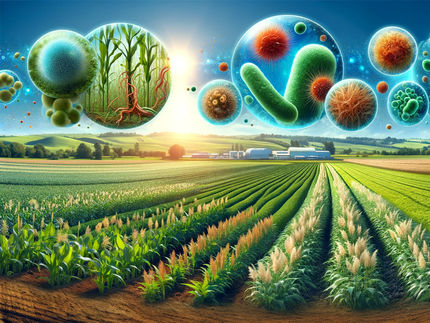Reducing manure and fertilizers decreases atmospheric fine particles
A decrease of agricultural ammonia emissions avoids mortality attributable to air pollution
Advertisement
Fine particulates have numerous sources – not only traffic, which is currently under particular scrutiny. Reducing agricultural emissions could also considerably reduce the particulate levels that are hazardous to health, concludes a study by researchers at the Max Planck Institute for Chemistry in Mainz, Germany. The scientists calculated that especially in Europe and North America, the atmospheric fine particle concentration would decrease substantially by reducing ammonia (NH3) emissions by fertilizer use and animal husbandry. If agricultural emissions were 50 percent lower, more than 250,000 deaths per year, caused by air pollution, could be avoided globally.
According to the World Health Organization (WHO), fine particulate matter with a diameter less than 2.5 micrometers (PM2.5) is particularly harmful to health, because the particles penetrate deep into the lungs and can cause cardiovascular and respiratory diseases. This significantly reduces life expectancy in many regions of the world. According to the “Global Burden of Disease”, a study that assesses mortality and disability from major diseases, injuries, and risk factors, outdoor air pollution is the fifth-ranked risk factor of global total mortality.

An important source of fine particulates: agricultural ammonia emissions from fertilizer use and animal husbandry.
Myriams-Fotos, pixabay.com, CC0
'Currently, the public debate primarily focusses on the particulate load from traffic, while other sources such as agriculture are neglected', says Jos Lelieveld, Director of the Atmospheric Chemistry Department at the Institute in Mainz. Particulate emissions from motor vehicles can make a critical contribution to local air pollution in urban areas, especially near roads with heavy traffic. However, most fine particulates (PM2.5) are the result of chemical processes in the air during transport by the wind. 'The concentration of fine particulates in the atmosphere could be drastically reduced by preventing the release of ammonia from agriculture', says Lelieveld, which is underpinned with recent calculations of his research team.
Ammonia reacts to form the salts that make particulates
In an earlier study, the Max Planck researchers pointed out that 3.3 million people around the globe died in the year 2010 as a consequence of air pollution. Meanwhile the estimates for recent years have increased significantly. The scientists emphasize that in many regions of the world industry and traffic are not the leading sources of air pollution, which is generally assumed, but that agriculture can play an important role, in addition to residential energy use for heating and cooking.
The scientists have identified the release of ammonia from animal husbandry and fertilizer use as a leading cause of air pollution, especially in large parts of Europe. Ammonia contains nitrogen which is an important nutrient for plants, but it escapes to the atmosphere from manure and by fertilizing agricultural crops. It reacts with other substances, such as sulphuric and nitric acid, to form ammonium sulphate and nitrate salts that make up the particulates.
50 percent less NH3 would avoid 250,000 deaths per year globally
In their present study, the scientists concentrate on four regions where particulate air quality limits are frequently exceeded: North America, Europe, South and East Asia. Their calculations show that a 50 percent reduction of agricultural emissions would lead to a global decrease in deaths attributable to air pollution of around eight percent. This figure corresponds to a mortality rate of 250,000 people per year. If ammonia emissions could be fully excluded, about 800,000 deaths from air pollution related diseases would be avoided globally.
'The effect of ammonia reduction on particulate formation is non-linear. Air quality improvement is most efficient after certain reductions have been realized. 'From this point on, however, the effect is exponential', explains Andrea Pozzer, Group Leader at the Max Planck Institute for Chemistry and leading author of the study. A reduction in ammonia emissions of more than 50 percent would, therefore, be highly effective and desirable, Pozzer adds.
Europe, especially, would profit from lower ammonia emissions
The scientists determined mortality rates in two stages: first, with the aid of an atmospheric chemistry model, they calculated how strongly fine particulates would be reduced by decreasing ammonia emissions. The results show that by cutting the global source by half, in Europe 11 percent less PM2.5 particulates would result, in the USA 19 percent and in China 34 percent. In Germany, the average level of fine particulates in the year 2015 was around 14 micrograms per cubic meter of air, meaning that in the 50 percent reduction scenario it would drop to about 12.5 micrograms per cubic meter.
Based on an additional model, which describes the public health impacts that occur for a given particulate exposure, the researchers calculated the influence on mortality by lung cancer, cardiovascular and respiratory diseases. In particular Europe would profit from a reduction in ammonia emissions and the consequent decrease of fine particulates: for example, a Europe-wide NH3 reduction of 50 percent would decrease mortality from PM2.5 by almost 20 percent, meaning that about 50,000 deaths per year could be avoided.
Andrea Pozzer and colleagues calculated that an ammonia reduction of this magnitude in the USA would lead to a 30 percent drop in the air pollution related mortality rate. In contrast, the computer models indicate smaller improvements for the same reduction in East Asia, about eight percent, and only three percent in South Asia.
Based on these results, Jos Lelieveld concludes: 'Emission policies, in particular in North America and Europe, should impose more stringent ammonia controls to effectively reduce fine particulate concentrations.' Sulphur dioxide (SO2) and nitrogen oxide (NOx) reduction measures are critically important for clean air, but should be complemented by a reduction of ammonia from agriculture, which can be implemented relatively efficiently and economically.


































































